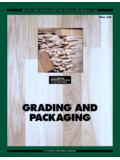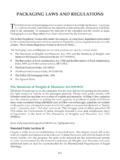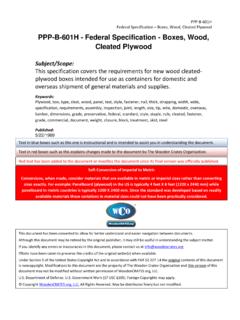Transcription of CODE OF HYGIENIC PRACTICE FOR EGGS AND EGG …
1 123 CODE OF HYGIENIC PRACTICE FOR eggs AND EGG PRODUCTSCAC/RCP 15-1976 INTRODUCTION 1251. OBJECTIVES 1252. SCOPE AND USE OF THE DOCUMENT Scope Use of the document Principles applying to the production, handling and processing of all eggs and egg products Relative roles of egg producers, processors and transporters Definitions 1293. PRIMARY PRODUCTION Environmental hygiene HYGIENIC production of eggs Flock management and animal health Areas and establishments for egg laying systems General HYGIENIC PRACTICE Collection, handling, storage and transport of eggs Egg collection equipment Packaging and storage Transport, delivery procedures and equipment Cleaning, maintenance and personnel hygiene at primary production Cleaning and maintenance of egg laying establishments Personnel hygiene, health, and sanitary facilities Documentation and record keeping 1424.
2 ESTABLISHMENT: DESIGN AND FACILITIES 1425. CONTROL OF OPERATION Control of food hazards Key aspects of hygiene control systems Temperature and time issues Specific process steps Microbiological and other specifications Incoming material requirements Packaging Water 150 Adopted in 1966. Amendments 1978, 1985. Revision Management and supervision Documentation and records Recall procedures 1506. ESTABLISHMENT: MAINTENANCE AND SANITATION Maintenance and cleaning Cleaning programmes Pest control systems Waste management Monitoring effectiveness 1507. ESTABLISHMENT: PERSONAL HYGIENE 1518. TRANSPORTATION 1519. PRODUCT INFORMATION AND CONSUMER AWARENESS Lot identification Product information Labelling Consumer education 15210.
3 TRAINING 152125 CODE OF HYGIENIC PRACTICE FOR eggs AND EGG PRODUCTSCAC/RCP 15-1976 INTRODUCTIONThis Code of HYGIENIC PRACTICE for eggs and Egg Products is intended to provide guidance for the safe production of eggs and egg products. A hazard analysis approach was used in determining the controls presented in this Code. The FAO/WHO document below was used to provide a risk-based foundation for the revised Risk assessments of Salmonella in eggs and broiler chickens. Microbiological Risk Assessment Series 1. FAO/WHO 2002 (ISBN 92-5-104873-8). Code of HYGIENIC PRACTICE for eggs and Egg Products takes into consideration, to the extent possible, the differing egg and egg product production systems and processing procedures used by countries. This Code focuses primarily on eggs produced from domesticated chickens.
4 The principles may also be applied to the HYGIENIC practices for egg production from other domesticated egg producing bird species ( duck, quail and goose). Therefore, the code is, of necessity, a flexible one to allow for different systems of control and prevention of contamination of eggs and egg Code addresses the two main sources of contamination of eggs :1. internally during egg formation, and 2. externally, at any point at or after laying. It takes into consideration the possibility of illness in the general population due to the consumption of eggs or egg products contaminated by Salmonella species, other enteric pathogens or other contaminants, as well as the susceptibility to illness of sectors of the population such as the elderly, children, and immunocompromised individuals. For microbiological contamination, this approach is consistent with the approach identified by the Joint FAO/WHO Expert Consultation on Risk Assessment of Microbiological Hazards in Foods (Rome, Italy, 30 April 4 May 2001).
5 1. OBJECTIVESThe objective of this Code is to ensure the safety and suitability1 of eggs and egg products by applying the Recommended International Code of PRACTICE General Principles of Food Hygiene (CAC/RCP 1-1969) to the particular case of eggs and egg products. The 1 Safety and suitability as defined in the Recommended International Code of PRACTICE General Principles of Food Hygiene (CAC/RCP 1-1969).126 ANIMAL FOOD PRODUCTION document describes the specific considerations for food hygiene and safety associated with all methods of primary production and processing of eggs and egg products, including the adequate measures for small-scale producers and SCOPE AND USE OF THE ScopeThis Code applies to the primary production, sorting, grading, storing, transport, processing, and distribution of eggs in shell and egg products of such eggs produced by domesticated birds and intended for human consumption.
6 Traditional delicacy eggs ( Balut, 1 000-year-old eggs ) are not within the scope of this Code. Use of the documentThe provisions of this document are supplemental to and should be used in conjunction with, the Recommended International Code of PRACTICE General Principles of Food Hygiene (CAC/RCP 1-1969). The Code also references other Codex Standards, Codes or Guidelines, including the labelling standards and the Codex Code of HYGIENIC PRACTICE for the Transport of Foods in Bulk and Semi-Packed Food (CAC/RCP 47-2001), when they apply to the HYGIENIC production of eggs and egg document consists of a series of principles, explanatory narratives and , shown in bold text, are a statement of the goal or objective that is to be achieved. Explanatory narratives, shown in italicized text, serve to explain the purpose of the stated principle.
7 Additional information to assist in the application of the stated principle is shown in normal text. Principles that are applicable to all phases of production, handling and processing of eggs and egg products are given in Section This Code is flexible to allow for different productions systems, size of operation and different systems of control of hazards during production, handling and processing of eggs and egg products. Recognition of the production and processing of eggs by small-scale/less developed egg producers/businessesIn the context of this Code, the expression small-scale egg producer refers to production systems based on the number of birds, or where automated collecting and sorting/grading machines are not generally used, or where water and other requirements are in poor supply thus limiting the number of birds that can be kept.
8 The maximum number of birds permitted in small-scale establishments may be set down in national legislation, codes of PRACTICE or other OF HYGIENIC PRACTICE FOR eggs AND EGG PRODUCTS (CAC/RCP 15-1976)Flexibility in the application of these requirements in this Code may apply to less developed egg producers, those producers with larger flocks that have less developed systems, and/or economic, water and/or power supply constraints, preventing investment in modern grading and packaging processes and infrastructure. Flexibility in the application of requirements on the primary production of eggs by small-scale and/or less developed egg producers can be exercised, where necessary. However, any microbiological or other control measures used should be sufficient to obtain safe and suitable eggs and egg products.
9 Such flexibility is indicated throughout the Code by the use of a parenthetical statement where practicable placed next to the particular provision where the flexibility is guidance on the issues facing small and less developed businesses, particularly in relation to implementing HACCP is under development and can be found in FAO/WHO Guidance to Governments on the Application of HACCP in Small and/or Less Developed Businesses (FAO/WHO, October 2006) Principles applying to the production, handling and processing of all eggs and egg products The following principles should apply, where appropriate and practicable, to the production, handling and processing of all eggs and egg products. v From primary production to the point of consumption, eggs and egg products should be subject to control measures intended to achieve the appropriate level of public health protection.
10 The Code is aimed at encouraging the safe production of eggs and egg products for human consumption, and gives relevant guidance to producers and processors, large and small, on the application of control measures throughout the entire food chain. It recognizes that there is a need for continuous, effective effort or controls, which should be applied, by primary producers in addition to processors, in assuring the safety and suitability of eggs and egg products. Good HYGIENIC , agricultural and manufacturing practices should be identified during primary production, shell egg processing and egg product processing. Such practices should be applied throughout the food production chain so that eggs and egg products are safe and suitable for their intended use. Both the relationship and impact of one part of the food production chain on another part should be identified to ensure that potential gaps in the chain are dealt with through communication and interaction between those in the production chain.















